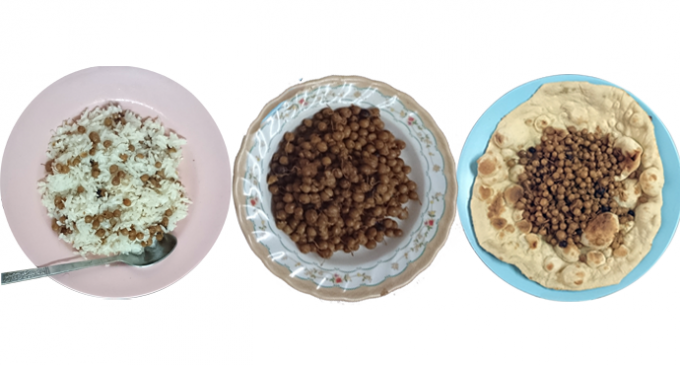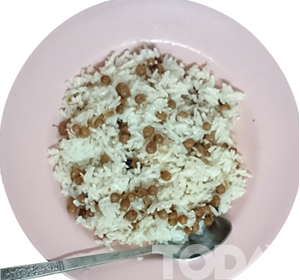Pebyoke, the common man’s breakfast

If I were asked what is one of the things I have cherished since I was a child, I would say it is pebyoke. Pe in Myanmar means peas and byoke means boiled. Pebyoke or boiled peas to Myanmar is very much like baked beans to westerners. It is part of the common man’s breakfast. My father was a civil servant and our family used to live on the third floor apartment of a four storied red brick apartment on a housing estate for civil servants. Fifty years ago, life was not very easy for a family of five living on the single earning of a civil servant. My mother had to budget carefully with whatever amount of money was handed over to her by my father at the end of each month to provide us with three square meals. Most families on the housing estate were in the same predicament and pebyoke was one of the most popular items for breakfast and even other meals as it was cheap to buy, convenient to prepare, easy to obtain and it tasted delicious.
Early every morning, round about 5 a.m., pebyoke sellers would make their round of the housing estate. All the

pebyoke sellers were women. And probably to distinguish themselves from each other, they all had different styles of announcing their product. Some would lengthen the first syllable pe. Some would lengthen the second syllable byoke. Another would shout out in a singsong voice. Still another seller would shout out in a curt tone, probably because she hadn’t had enough sleep. It was the style of shouting out ‘pebyoke’ that was their personal trademark. Every house-wife had her own favourite seller because of some reason become a favourite:… because of the way her pebyoke is steamed.… because she looks clean. … because she gives a bit of extra pebyoke to her regular customer…. because she sells on credit, … because you can hear gossip about the neighbourhood, etc., etc. In the grey light of dawn, it was difficult to distinguish them from each other by appearance. All of them looked the same with brownish baskets on their head, unless of course, she was extra fat or extra tall or extra small. Hearing the voice of their favourite pebyoke seller, the housewife, or the person assigned to be on the lookout the seller catch the attention of the pebyoke lady with a loud clap and called out “Pebyoke thair la ba ohn!” (Pebyoke seller please come!) in their own style from the balcony. No matter whether you called out from the fourth floor balcony, or from the first floor balcony, she would climb sprightly up the stairs and be at the door at the same time the buyer opened the door. She would remove the round enamel tray, which contained the weights and scale, covering the bamboo basket. Then, she would uncover the steaming pebyoke wrapped in a thick cloth, sometimes a pasoe, or nether garment of a Myanmar man, to keep it warm and ask “How many ticals, sister?” Yes, pebyoke was sold by weight. One viss was about 3.5 lbs and one viss contains one hundred ticals. The amount the buyer bought depended on how she was going to prepare it, the size of the family and of course, her budget. Usually, in those days, the cost of about 20 ticals of pebyoke was just around one kyat and it would be enough for the breakfast of a family of five when mixed with rice. Nowadays, 20 ticals of pebyoke would cost 400 about kyats, still cheap compared to a plate of rice noodles in fish gravy which would cost about the same in cities and big towns.
Pebyoke is one of the favorite breakfast food of the Myanmar people. It is also a convenience food. A breakfast of pebyoke is very easy to prepare as it is already cooked. Usually, the pebyoke is mixed with left over rice from the previous night’s dinner, but freshly cooked rice is also used. The rice and pebyoke are mixed thoroughly with the hand, and a bit of unheated sesame or peanut oil is poured on the mixture and a bit of salt is added to give extra taste. The white rice with the golden brown peas has a very appetizing appearance and has a slight shimmer and a good aroma because of the addition of a bit of peanut or seseme oil. It is shared among the members of the family who sit on the floor around the low round traditional Myanmar dining table enjoying the sweetish taste of the peas and the slightly hard rice left over from the dinner. It goes wonderfully well with hot green unsweetened tea. It goes equally well with the sweet tea or coffee made with a dollop of condensed milk and many spoonful of sugar. Instead of mixing it with rice, pebyoke may be eaten with a bit of oil and salt added to it and placing it on or rolling it in small pieces of nanbya, or thin flat sweetish oven-baked naan bread. Some enterprising pebyoke sellers also bring along nanbya for sale. Other-wise, freshly made nanbya can be bought at the local teashop. In my boyhood days, all teashops had a big waist-high earthen oven with charcoal placed at the bottom of the oven to heat the sides. Beside the oven would be a table on which the nanbya maker would take small pieces from the big ball of soft dough made of wheat flour and make them into small balls and roll them with a rolling pin till they became flat, fairly thin and round. They were then placed on a pad made of cloth, the size of a nanbya, and were stuck to the heated inner wall of the oven. Within a few minutes, the flat bread would be ready. As the nanbya was quite hot, the nanbya maker threaded the nanbya with a thin strip of bamboo and you could hold it by the string to take home without getting your hand singed.
Pebyoke is a versatile food. Apart from eating it with rice or nanbya, pebyoke can also be eaten with pratha (Indian flat bread) and ei kya kway (Chinese fried dough stick (you tiao)). It can also be made into a simple dish for lunch by topping it with some crispy fried shallot and adding a spoonful of oil. It can also be stir-fried together with a variety of ingredients such as cooked rice, or egg, or bamboo shoot or just fried with a bit of onion and garlic. It can be made into a simple salad with the addition of sliced onion, a dash of oil and a bit of salt, or it could be served with steamed glutinous rice or glutinous rice cooked with oil and a bit of turmeric. It is also used to garnish stir fried flat rice noodle originating in the southern part of Myanmar, and other rice based snacks.
Pebyoke sellers usually make the pebyoke themselves. The process is simple. Zataw Pe (garden peas) (Pisum sativium) are kept in a sieve covered with a wet cloth for two days and rinsed about twice a day, so that they are kept moist and tender shoots appear. The young shoots make the pebyoke tastier. The peas are then steamed in an earthen pot with small holes at the bottom which is placed over another pot containing water. A piece of htan nyet, or palm sugar, is added to it to give it a rich brownish colour and also to add flavour and aroma to it. A bit of baking soda is also added to soften it. The peas are steamed for about an hour till they become soft. In order to be in time for those customers who rise early, the pebyoke seller has to get up early in the morning at round about four o’clock to steam the peas so that she can leave her house at about five.
While families enjoy their pebyoke break-fast, the seller has to hawk her pebyoke till she has sold out all by

about seven o’clock. She then makes her way quickly to the nearest market and buys foodstuff with the small profit she has made and then goes home to prepare breakfast and also lunch which is taken to work by her husband and to school by her children in multi-layered small tiffin carriers.
The pebyoke seller’s life is a tough one as she has to wake up early every day to prepare the pebyoke and walk long distances with a heavy basket on her head to hawk it, rain or sunshine. In spite of this, her profits are meager. However, the outlay is small and there is no worry about not being able to sell all the day’s product by the end of the morning.
In Myanmar, pebyoke is usually associa-ted with the not so well off, especially the working class, but in actual fact, it is equally relished by the wealthy and a typical Myanmar would readily exchange the most elaborately prepared breakfast with a plate of rice mixed with pebyoke.
By Myo Myint
./wp-content/uploads/2018/10/Emirate-Online-TDY.png)

















There are no comments at the moment, do you want to add one?
Write a comment